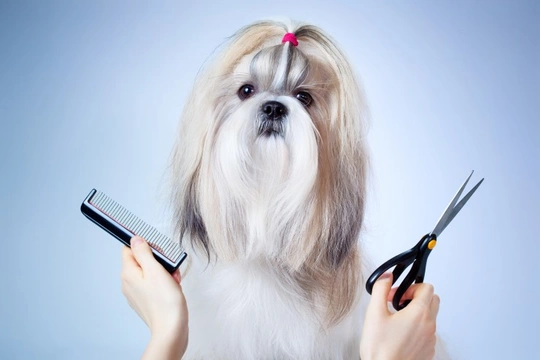
Can you overgroom a Shih Tzu?
The Shih Tzu dog breed is the UK’s most popular longhaired dog, and they also have among the highest of care needs when it comes to grooming and managing the coat itself. You can of course opt to have your Shih Tzu’s coat clipped or trimmed off shorter to make it easier to manage – but even if you do, brushing and grooming your dog is something that you will need to make time for almost every day.
For Shih Tzus that keep their very long, flowing coat, keeping this coat healthy and in good condition requires a commitment to daily care and without this, the coat may soon become knotted and tangled. This is the most common problem faced by longhaired Shih Tzus – but on the flipside, is it possible to groom a Shih Tzu too much, and how would you know if you were doing this?
In this article, we will answer the question of whether or not it is possible to groom a Shih Tzu too much, and tell you how you can identify problems that may be caused by brushing and grooming. Read on to learn more.
So, can you overgroom a shih Tzu?
It is very hard to overgroom a dog, particularly one with such a long coat as the Shih Tzu. You may reach a point where the dog’s coat is in optimum condition and continuing to brush them within any given session will provide no further benefit, but even if you spend hours grooming your dog one day, you’ll still need to do it all again tomorrow!
Overgrooming to the point that you make the dog’s skin sore, or start to pull their coat out, is very hard to do but not impossible – because your dog will almost certainly protest. Assuming that you’re using the right tools and grooming your dog in the right way, it would be hard to overgroom them to the point of causing problems. However, if the tools you are using aren’t the right fit or your technique isn’t right, you might cause problems like sore skin, hot spots and more.
Next, we will look at some of the mistakes to avoid and issues that can arise if you use the wrong tools or technique to groom your Shih Tzu.
How long should you brush your Shih Tzu for?
How long you need to spend in any one session grooming your dog depends on the condition of their coat at the time – so how long you spend on this might be very variable and take longer on some days than others.
Consider your dog’s grooming to be finished for the day when they have no knots, mats or tangles and their coat has been combed or brushed out from root to tip across all of their body.
Using the right tools
You will probably need quite an array of tools in your arsenal to effectively groom your Shih Tzu, although you probably won’t need to use all of them every day.
You should invest in a pin brush with blunt pins, a soft brush, a comb with a blunted pointed end, and maybe a detangling tool too as well as a slicker brush. You may also want to use a smoothing or conditioning spray to help to work out knots and tangles.
Ensure that the tools that you use aren’t too hard or sharp to be comfortable for your dog, and that you have a tool that can work right down to the skin without irritating it.
Grooming technique
There are a range of factors that help to contribute to developing the right grooming technique, and this is a learned process that you will improve upon with time. If your technique isn’t right, you might make grooming uncomfortable or even painful for your dog, or miss important areas and fail to groom the lower layers of the fur.
The basic factors that contribute to a good grooming technique include using the right amount of pressure – not too hard so that this makes the skin sore or your dog uncomfortable, and no so soft that grooming isn’t really effective.
Knowing the right tool for the right job is important too, and different tools may be needed for different areas of the body, and different problems. The angle and direction in which you brush is something else to bear in mind, as is ensuring that you work across the whole coat and not just the visible and top layers.
Full body grooming
As mentioned, you need to groom all of your dog’s fur, including the feathering on the legs, the beard, in the armpits and groin, and under the belly. It is important to groom your dog evenly, and not to spend too long at a time working over and over on one particular area, as this may make the skin sore.
If you’ve been trying to tackle a certain area or problem for a while, move on to another area and go back to it later on. If you like to sit and watch TV with your dog in your lap grooming them to chill out, make sure you’re not just going over the same area over and over!
Also, take your cues from your dog, and watch their reactions carefully. If a dog that is normally highly receptive to grooming becomes fidgety or irritable, you may be doing something that is painful or irritating to them, or have been working on them for too long.
If grooming becomes painful or annoying to your dog, they’ll be reluctant to let you do it regularly, which can make life very hard for both of you.



